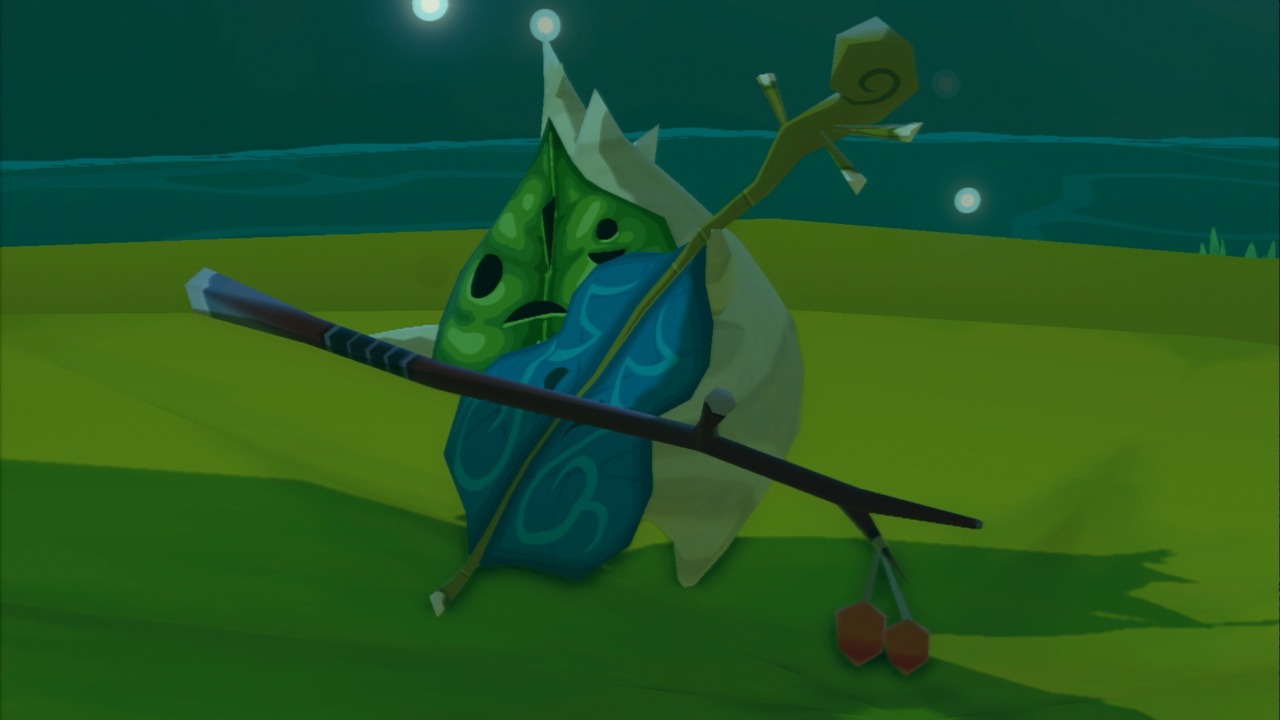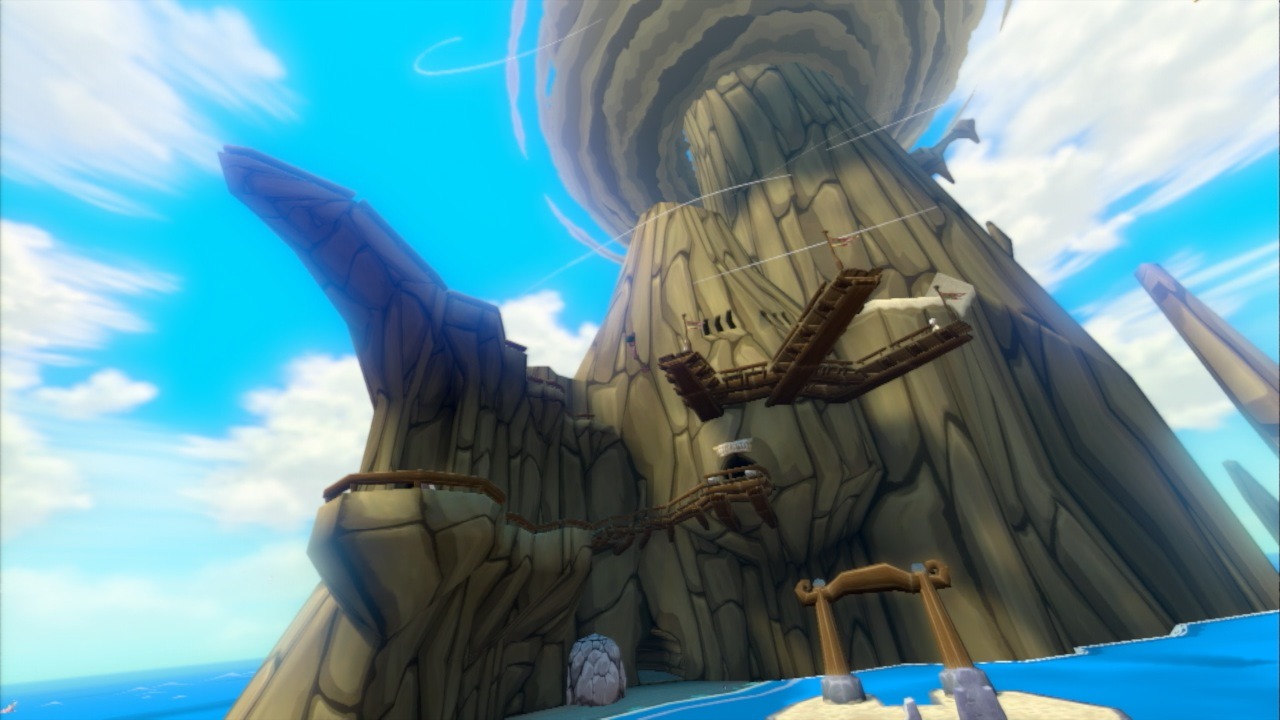It's strange to think how the elegance of The Legend of Zelda: The Wind Waker's bold, thick strokes, endearingly stumpy protagonist, and lusciously saturated palette ever caused so much controversy back in 2003, but even a decade later, the game's legacy remains defined by its visuals.
In hindsight, The Wind Waker's distinctive, cel-shaded visuals have retained their allure, even as other, more recent, Zelda games have started to lose lustre. In bringing the game to the Wii U, Nintendo has updated it to run in 1080p widescreen, but has also reworked the lighting and shadows. The Wind Waker HD is no mere upscaling, then, and Nintendo further alters the look of the game by adding thick, foggy layers of bloom and a slightly adjusted colour palette. While the choppy expanses of ocean look untouched, for instance, the sky loses some of its shine and the clouds are blurred, creating a more realistic look.
This is an undeniably beautiful adaptation, but fans of the GameCube original will find themselves reaching for their TV's contrast setting, especially when fighting bosses in enclosed spaces. The electric, pillowy blasts of Gohdan used to bathe the room in a piercing yellow, but no more, and the rich orange and red hues of Gohma have been disappointingly dimmed to shades far closer to brown.
Yet The Wind Waker HD's occasionally muted palette does little to diminish the powerful effect of revisiting its fresh take on the series' ubiquitous mountains, temples, and villages, and a decade of ballooning real estate in the open-world genre doesn't make the game's oceanic overworld feel any smaller. Link may have later taken to the clouds in Skyward Sword, but sending him to the open seas still feels like a fresh way for Nintendo to keep players' feet off the ever-familiar Hyrule Field.

It's the way The Wind Waker's vibrant art is intertwined with its evocative soundtrack and cast of characters, notably the boyish Link with his humongous, expressive eyes, and the stern weariness of The King of the Red Lions, his talking boat companion, that propels the adventure and exploration. The oceans, sunken treasures, and pirate galleys take the series away from its more traditional fantasy setting and place it into fresh water, its swashbuckling theme completed by the addition of a ghost ship that appears on the horizon at night.
Structurally, however, The Wind Waker was, and still is, trapped in the shadow of the seminal Ocarina of Time, and plays out in the series' classic fashion as opposed to the broad experimentation of its predecessor Majora's Mask. There's no new content in the HD update, so The Wind Waker still moves to the same rhythm as before: its first half is an adventure of thundering and thrilling pace, but an underweight second half stretches itself thin with an exasperating fetch quest that requires deep pockets and a cast-iron level of perseverance.
Map maker Tingle's infamously pricy and tedious fetch quest has been, thankfully, made easier, with only three (of the original eight) triforce maps now requiring deciphering. The game also starts you off with a wallet that can hold 500 rupees, as opposed to the original's 200. Even with the tweaks, the quest still feels enormously unwelcome, forcing you to ferret around the game's periphery side quests as opposed to letting you discover these bonus areas naturally.

Another new addition is the Swift Sail enhancement, obtained through the auction house in the game's wonderful, character-packed Windfall Island, a winding locale rich with dotty locals, hidden treasures, and a massively disgruntled game operator who allows you to part with your money to play an intentionally underwhelming game of Battleship. The Swift Sail boosts your speed on the open seas by 50 percent, and also automatically repositions the wind to always be behind you, alleviating the problem of constantly having to conduct aboard your ship using the Wind Waker, the magical baton which never conjured up the same sense of wonder as Link's time-shifting ocarina.
The Wind Waker is perhaps a little too simplistic, failing to tax you in its dungeon puzzles, boss encounters, or regular swordplay. To compensate for this, Nintendo has added the Hero mode first seen in Skyward Sword, which makes enemies do double damage and removes health recovery outside of potions and fairies. Hero mode adds a fair amount of challenge to the game, forcing you to remain wary of the occasional stray hit as opposed to simply shrugging it off. The Tingle Tuner from the original game, which required you to attach a Game Boy Advance to the GameCube, has also been replaced by the Tingle Bottle, which lets you tap into Miiverse to randomly dot messages around the shores of others players' islands. The Picto Box has also been upgraded to allow for 12 photographs, and adds the ability for Link to take his very own selfies.
These minor additions slot nicely into game's core rhythm of unfolding item unlocks--such as a boomerang, grappling hook, bombs, and of course the classic hookshoot--which allows players to slowly, satisfyingly chip away and discover the secrets of its seven main dungeons. That sense of exploration is only enhanced by the Great Sea, a 7x7 grid of open ocean with a point of interest dotted in each square. Off the beaten path lies valuable secret items, lucrative galleys to plunder, and powerful, ancient forces to win over to your quest. Like all Zelda games, The Wind Waker is a weave of puzzle solving, combat, and discovery, with each main dungeon involving a puzzle-laden search for a key that allows you to square off against each of the game's imposing boss monsters.

There's the chore of Tingle to overcome before you can get to The Wind Waker's best bits, but the game is a small and well-formed adventure, albeit one with both crisp blue skies and sudden murky storms. Some of the series' most impressive moments are here: an ancient city preserved in time under the sea, a battle with a giant bird on top of a collapsing fortress, and a moment of reunion with an aging, worried grandmother in a sequence that evokes genuine sadness.
The Legend of Zelda: The Wind Waker HD is a loving restoration of a bold and beautiful adventure, with Nintendo shifting some elements of the original game's aesthetic, and streamlining the pace where it had occasionally sagged. The Wind Waker is a game about a young hero saving the world from the past actions of old men, but its HD update reaffirms that Nintendo's most colorful Zelda game remains timeless.
This review was amended on September 19, 2013, after the original text incorrectly stated that The Legend of Zelda: The Wind Waker HD ran at 60 frames per second. GameSpot apologises for the error.